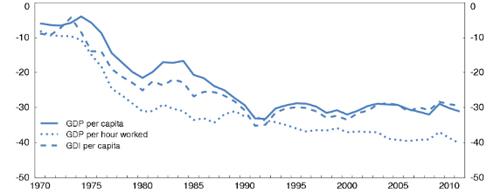Economic Survey of New Zealand 2013
Economic Survey of New Zealand 2013
The New Zealand economy is
beginning to gain some momentum, with post
earthquake reconstruction, business investment and household
spending gathering pace. Risks to growth remain, however,
stemming from high private debt levels, weak foreign demand,
large external imbalances, volatile terms of trade, a severe
drought and an exchange rate that appears overvalued. The
main structural challenge will be to create the conditions
that encourage resources to shift towards more sustainable
sources of prosperity. Incomes per head are well below the
OECD average, and productivity growth has been sluggish for
a long time. Lifting living standards sustainably and
equitably will require structural reforms to improve
productivity performance and the quality of human
capital.
Gap to the upper half of OECD countries[1], per cent

[1] Percentage gap with respect to the simple average of the highest 17 OECD Countries in terms of GDP
Source: OECD (2013), Economic Policy Reforms 2013: Going for grwoth, OECD Publishing
Download Data in Excel
Macroeconomic policies strike the right balance between supporting the recovery and ensuring medium term sustainability. Monetary policy is appropriately accommodative, given the high exchange rate, weak employment growth and subdued inflation. However, domestic demand is firming, and price pressures from earthquake rebuilding and housing markets are likely to strengthen. The largely Australian owned banking system is in good shape, and effectively supervised, but rising house prices could pose risks to financial stability. Fiscal consolidation is on track to restoring surpluses. Achieving sustained reductions in government debt will establish a favourable starting position for confronting the longer term cost pressures resulting from demographic ageing. It will also tend to raise national saving rates, thereby reducing external vulnerabilities.
Policy makers are increasingly attuned to social equity and welfare. Though New Zealand ranks highly on many dimensions of well being, some show a wide dispersion. The redistributive power of the tax and transfer system is around the OECD average. To soften the impact of henceforth tight budgets on social protection, reforms are underway for improved prioritisation, efficiency and coherence in service delivery by central government. Tax and spending changes to bolster fiscal policy’s contributions to growth, equity and the environment remain important. Welfare reforms are attempting to reduce long run benefit dependency by emphasising education and training of at risk youth, with greater conditionality on beneficiaries and strengthened accountability on public and private providers. Improving education, health, employment and social outcomes for the large Maori and Pacific minorities is needed to reduce social disparities.
Boosting productivity is key to long term growth prospects. Low trade intensity and limited engagement in global value chains suggest New Zealand is not reaping the full productivity enhancing benefits of globalisation, perhaps in part because of the persistent overvaluation of the exchange rate. Inefficiencies in the information and communications technology infrastructure may undermine international connectedness. Regulatory uncertainties may be stunting competitive pressures and opportunities for foreign investment. Meanwhile, low levels of research and development may also be impeding the adoption of foreign technologies and ideas. New Zealand makes generally efficient use of its abundant natural capital, which bodes well for the sustainability of growth. The carbon price signal remains muted in the absence of internationally agreed emissions targets, and some tax settings appear to favour fossil fuel exploration.
There are weaknesses in school to work transitions, notably among ethnic minorities, hindering the development and use of the nation’s human capital. Standardised tests indicate a long “tail” of school underachievers, despite high average scores. The high drop out rate is a concern; as part of its growth agenda, the government aims to reduce it rapidly. Lack of school qualifications results in youth unemployment, which has increased sharply since the crisis, and high rates of youth neither in education nor in employment or training. The government has targeted improved teaching quality to reduce disparities in scholastic achievement. It has also created new vocational pathways to engage at risk youth and to strengthen education–work linkages.
[Original page with links to full report and more data: Economic surveys and country surveillance - Organisation for Economic Co-operation and Development]


 Palestine Forum of New Zealand: A Message To Pope Leo XIV
Palestine Forum of New Zealand: A Message To Pope Leo XIV Pacific Islands FFA: Ten Years Together - Celebrating Regional Solidarity Through The NTSA
Pacific Islands FFA: Ten Years Together - Celebrating Regional Solidarity Through The NTSA ITUC: The Greatest Threat To Democracy In 80 Years - Stop The Billionaire Coup
ITUC: The Greatest Threat To Democracy In 80 Years - Stop The Billionaire Coup Save The Children: A Third Of 5-Year-Olds Will Be Spared Unprecedented Lifetime Exposure To Dangerous Heat If World Meets 1.5°C Temperature
Save The Children: A Third Of 5-Year-Olds Will Be Spared Unprecedented Lifetime Exposure To Dangerous Heat If World Meets 1.5°C Temperature Access Now: NSO To Pay $168 Million In Damages To WhatsApp For Pegasus Spyware Hacking
Access Now: NSO To Pay $168 Million In Damages To WhatsApp For Pegasus Spyware Hacking NIWA: New Study Reveals Climate Change Is Already Impacting The Andes
NIWA: New Study Reveals Climate Change Is Already Impacting The Andes